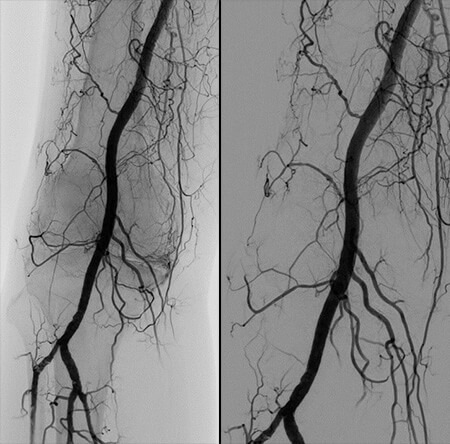Geniculate Artery Embolization (GAE): A Minimally Invasive Option to Manage Knee Pain from Osteoarthritis
Osteoarthritis (OA) is a leading cause of chronic pain and disability in the US, with knee OA accounting for more than 80 percent of the total disease burden. It is estimated that knee OA affects up to 19 percent of American adults 45 and older. Patients typically report knee pain with activity, stiffness, and decreased range of motion.
GAE is a novel procedure to close off abnormal blood vessels in the knee and help alleviate pain associated with knee OA. It is performed by Interventional Radiologists with specific expertise in using real-time imaging guidance to navigate a small catheter to the knee joint and deliver microscopic beads that block arteries. The procedure is performed through a pinhole incision at the groin with the use of x-ray dye. By blocking blood flow to the knee, inflammation associated with osteoarthritis is decreased and pain is reduced. Studies have shown significant improvements in pain in 60 percent to 80 percent of patients, as well as a significant decrease in pain medication use. Although pain relief typical extends for 6-12 months, a few studies have documented benefit beyond 2 years.

Why choose GAE?
Treatment options for knee OA range from conservative measures, such as physical therapy, activity modification, and anti-inflammatory medications, to more aggressive surgical options, such as a knee replacement. Minimally invasive alternatives to surgery include intra-articular injections and genicular nerve ablation.
Joint injections, typically with steroids, can provide relief that may last between 3-6 months. However, there is concern that repeated joint injections can accelerate osteoarthritis and the need for a knee replacement in the future.
Physical therapy has been shown to result in better pain relief and improved functional outcomes compared to joint injections with steroids. Although effective, participating in physical therapy can be time consuming and expensive, as well as logistically challenging to schedule.
GAE is another minimally invasive option to consider, particularly in patients who have not had significant or long-lasting pain relief from more conventional alternatives. GAE is also an option for patients who are not candidates for knee surgery or elect to avoid/delay a more invasive procedure.
Who is a good candidate for this procedure?
Patients with mild to moderate knee pain from osteoarthritis who have tried conservative management or more conventional, minimally invasive interventions for at least 6 months without significant improvement are ideal candidates. Patients with severe osteoarthritis may derive benefit from the procedure; however, improvement has not been shown to be as durable as in patients with more mild disease.
What are a patient’s expectations surrounding the procedure?
GAE is an outpatient procedure that takes approximately 1-2 hours and done with sedation through an IV. Patients typically go home the day of the procedure.
After the procedure, a small bandage is placed over the access site at the groin. Patients typically leave after 2-6 hours of recovery, depending on how the artery in the groin is closed. Mild bruising is expected the first few days after the procedure and can be managed with anti-inflammatory medications.
Overall risks are low but include complications at the arterial access site (for example, a blood bruise, or hematoma), skin color changes around the knee which self-resolve over a few days to weeks, and mild soreness around the knee which can last for about 1 week after the procedure. These will be further discussed in consultation.
Pain typically improves soon after the procedure and generally continues to improve for ~6 months. Pain relief has been shown to persist in some studies for 2-4 years.
Will insurance companies cover GAE?
GAE is a novel procedure for managing patients with knee pain from OA. As such, coverage by insurance companies, although not universal, continues to increase as more studies are published demonstrating its safety and effectiveness. Our staff will work with your insurance provider to understand if the procedure is covered. If not, alternatives are available to ensure that you are able to get the care you need.
How can I be evaluated for GAE?
If you are interested in learning more about GAE, please contact our staff to set up an appointment for consultation. Alternatively, you may reach out to your care team to place a referral to UCSF Interventional Radiology. From there, our staff will work with you directly to schedule the consultation.
- UCSF Interventional Radiology
Phone: (415) 353-1300
Fax: (415) 353-8570 - How to refer to UCSF Interventional Radiology

